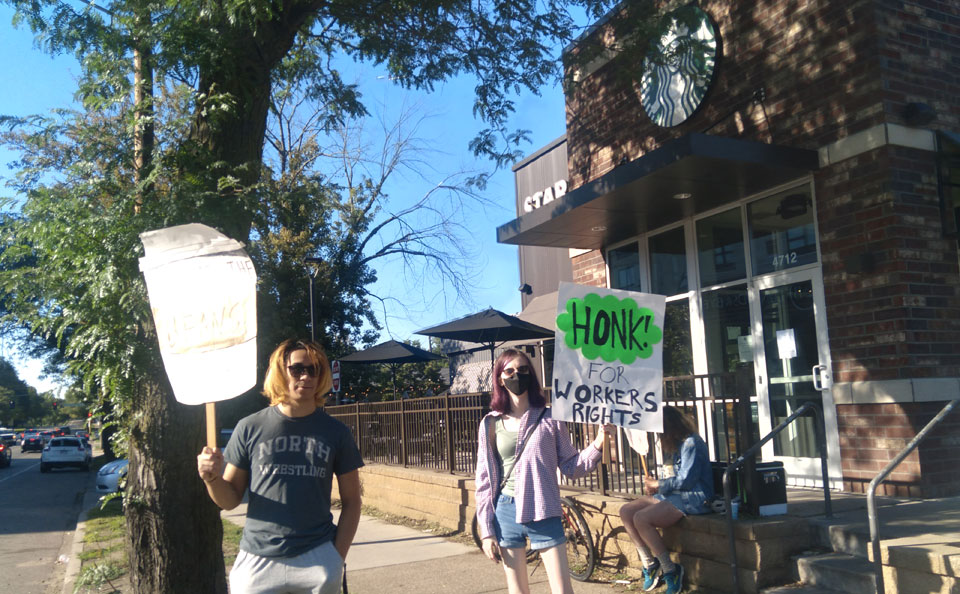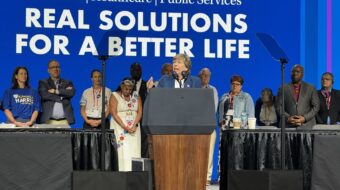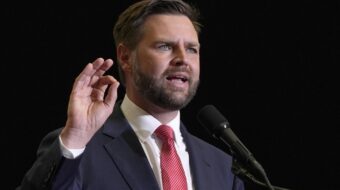
A “tip-in” is a basketball term. But what’s a “sip-in”?
The answer from Starbucks workers around the country who seek to unionize themselves and their stores is it’s the latest tactic in their escalating campaign for that goal: Coordinated action coast to coast to support unionizing and demand the firm stop union-busting and start bargaining.
It’s also a variation on the sit-ins civil rights activists used during their pro-integration campaigns 60 or more years ago against segregated restaurants in the South. Remember the sit-in by Black North Carolina A&T students at a Greensboro lunch counter in 1960? Same tactic.
Organizers with Starbucks Workers United (SWU), the grass-roots effort that is mobilizing the workers from coast to coast, say the sip-ins aim to draw customer support for their struggle by an unusual tactic: Pay the baristas and servers with big tips when you enter a Starbucks store—but don’t buy any coffee.
The best, but not the sole alternative: Grab a cup and draw a glass of water and drink it instead. If you must order coffee, identify yourself citing the local union.
“A group of community allies, wearing union shirts and buttons,” will be “spending as much time as permitted in a Starbucks café–after ordering drinks using union slogans as names and tipping well!” SWU explained in its August 16 newsletter to members.
“The goal is to create a celebratory environment and make connections with workers and customers who could become community allies. Workers feel supported, managers feel watched, and community allies get to tangibly support the campaign.”
And if you join the tip-ins on Labor Day itself—the campaign is running all weekend—the pro-union workers will ask you to sign their #NoContractNoCoffee pledge, “in which allies commit to taking direct action with workers in their fight for a union contract.” Their aim is 30,000 names.
The sip-ins aren’t the sole tactic Starbucks baristas and their allies are using to keep the public’s eye on their cause—a cause that resonates with so many other low-paid capitalist-exploited workers, including port truckers, adjunct professors, and fast food workers, nationwide.
In Buffalo and Minneapolis, workers have had to resort to walkouts after Starbucks bosses, continuing their long union-busting campaigns, fired lead pro-union organizers. The entire unionized store in Buffalo—whose win touched off the nationwide drive—walked after its bosses fired the campaign chair and lead bargainer.
Starbucks workers will also march on state capitals in deep-red Oklahoma and Texas, In These Times reports. Colorado baristas will show solidarity and a sense of labor history, too: They will march for themselves and to honor the Mine Workers and their families gunned down, at the demand of Rockefeller interests, by National Guard troops in the 1914 Ludlow Massacre.
In These Times reported the Starbucks workers are emphasizing intersectionality in their sip-ins, not just region to region, but issue to issue. In Boston on September 4, for example, the sip-ins will coincide with a campaign to preserve abortion rights. In Worcester, Mass., they’ll be in conjunction with a Gay Pride celebration.
In the Twin Cities, Rebecca Pera reports hundreds of baristas and their supporters took to the streets on August 30 in “The Pumpkin Spice strike,” because the firm introduced its annual autumn menu that day. It’s the second forced walkout in Minneapolis in less than a month. The first one lasted two days.

The Minneapolis workers demand management bargain with the union, that it reinstate illegally fired organizers, and that it provide clear and consistent communication to workers.
Workers at the 47th and Cedar Avenue Starbucks store in Minneapolis won their election to unionize in May. Shortly thereafter, union baristas sent requests to bosses to start bargaining meetings to create an initial contract.
Four months later, workers are still asking to begin bargaining in good faith, despite inconsistent messaging from management and delays from Starbucks to begin the negotiating process.
Some Minneapolis workers suspect Starbucks is intentionally dragging out the initial negotiations as an effort to bust the union and intimidate workers from continuing to organize.
“They are using stalling tactics,” explained Emily Mahoney, union barista and member of the negotiating team at the Minneapolis store. “Since we requested to begin bargaining in May, management has told us that they won’t give us the information we need and there has been a lot of miscommunication from them. It’s as though they are trying to distract us from getting them to sit at the bargaining table.”
Starbucks is also trying other union-busting schemes, many of them illegal, to stop or discourage organizing. Besides illegally firing at least 80 organizers nationwide, it’s closed at least two unionized stores—again illegal retaliation—in Ithaca, N.Y., and Kansas City, Mo. And it’s even taken a leaf from the union-busting tactics of another notorious boss, Amazon’s Jeff Bezos.
The Starbucks Workers United newsletter reports that after the union won 6-1 at an Overland Park, Kansas store—defying Starbucks’ illegal and intimidating firing of four organizers–the firm now charges the National Labor Relations Board tilted that election in favor of the workers. SWU calls the firm’s letter to workers about the NLRB’s bias “a PR stunt.”
Amazon leveled that same NLRB bias charge against the independent, grass-roots Amazon Labor Union after that union’s decisive election win at a Staten Island, N.Y., warehouse, earlier this year. Bezos owns a majority share of Amazon.
On September 1, an NLRB hearing officer in Phoenix, Ariz., where the Staten Island case was moved to avoid the appearance of prejudice either way, ruled for the union and said Amazon proved nothing about the NLRB’s alleged pro-union “interference.”
The Starbucks workers may have influenced one more change, in the firm’s corporate suite. CEO Jeff Schultz quit on September 1, with the number of unionized Starbucks stores nearing 250 nationwide. He didn’t say why.
Starbucks Workers United welcomed his successor, Laxman Narasimhan, hoping he’ll end Schultz’s extreme anti-union tactics and retaliation.
“We are hopeful Mr. (Laxman) Narasimhan will end Starbucks’s scorched earth union-busting campaign and work with all Starbucks partners to make Starbucks a better company and better place to work,” said Starbucks Workers United organizing member Michelle Eisen.
“This is the perfect opportunity for Starbucks to end the wrongful terminations, store closings, and war against workers, and instead embrace our union and sign the fair election principles” workers presented to Schultz and local store managers. The managers reject the principles and Schultz routinely ignored the workers’ open letters.













Comments